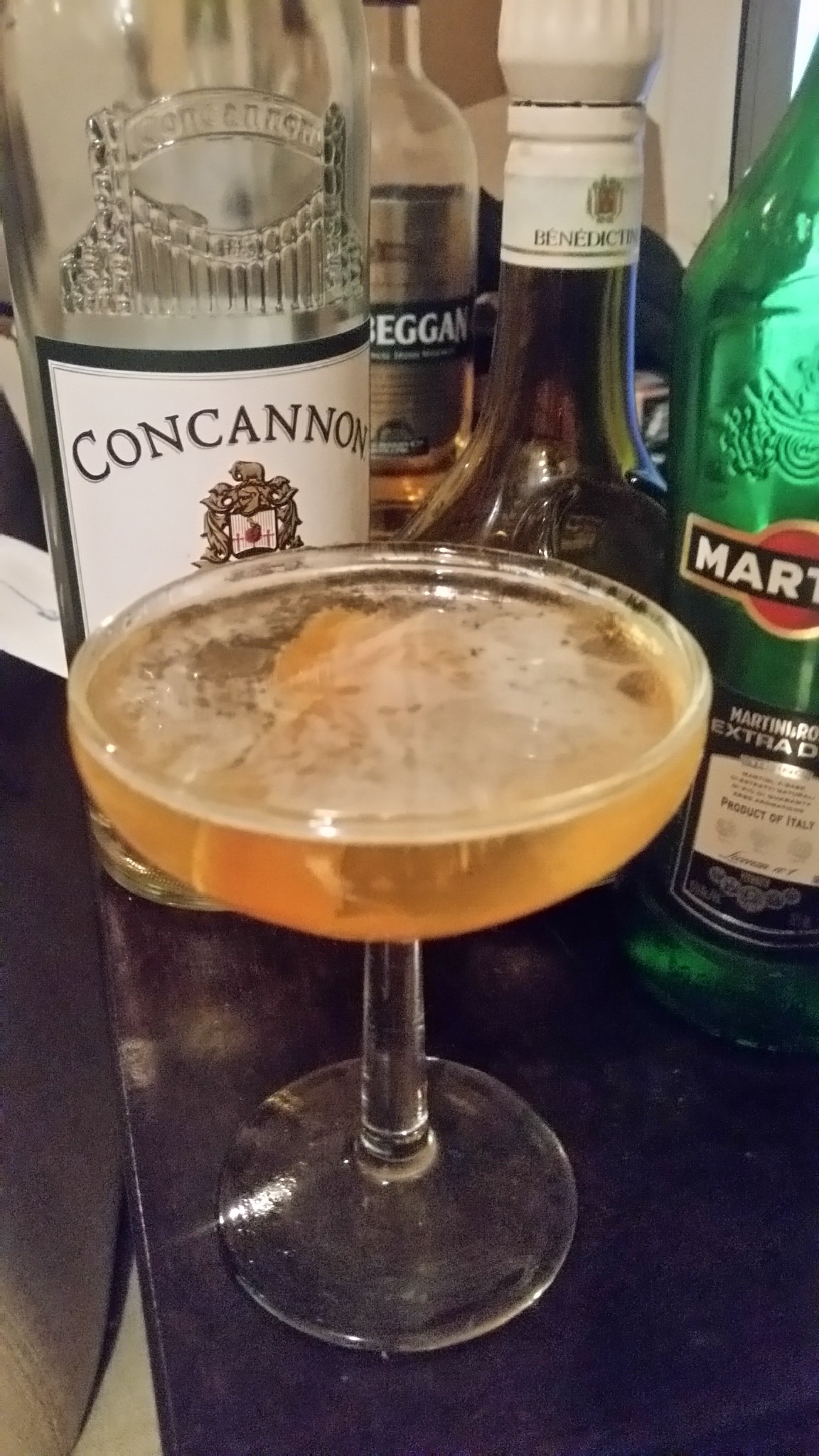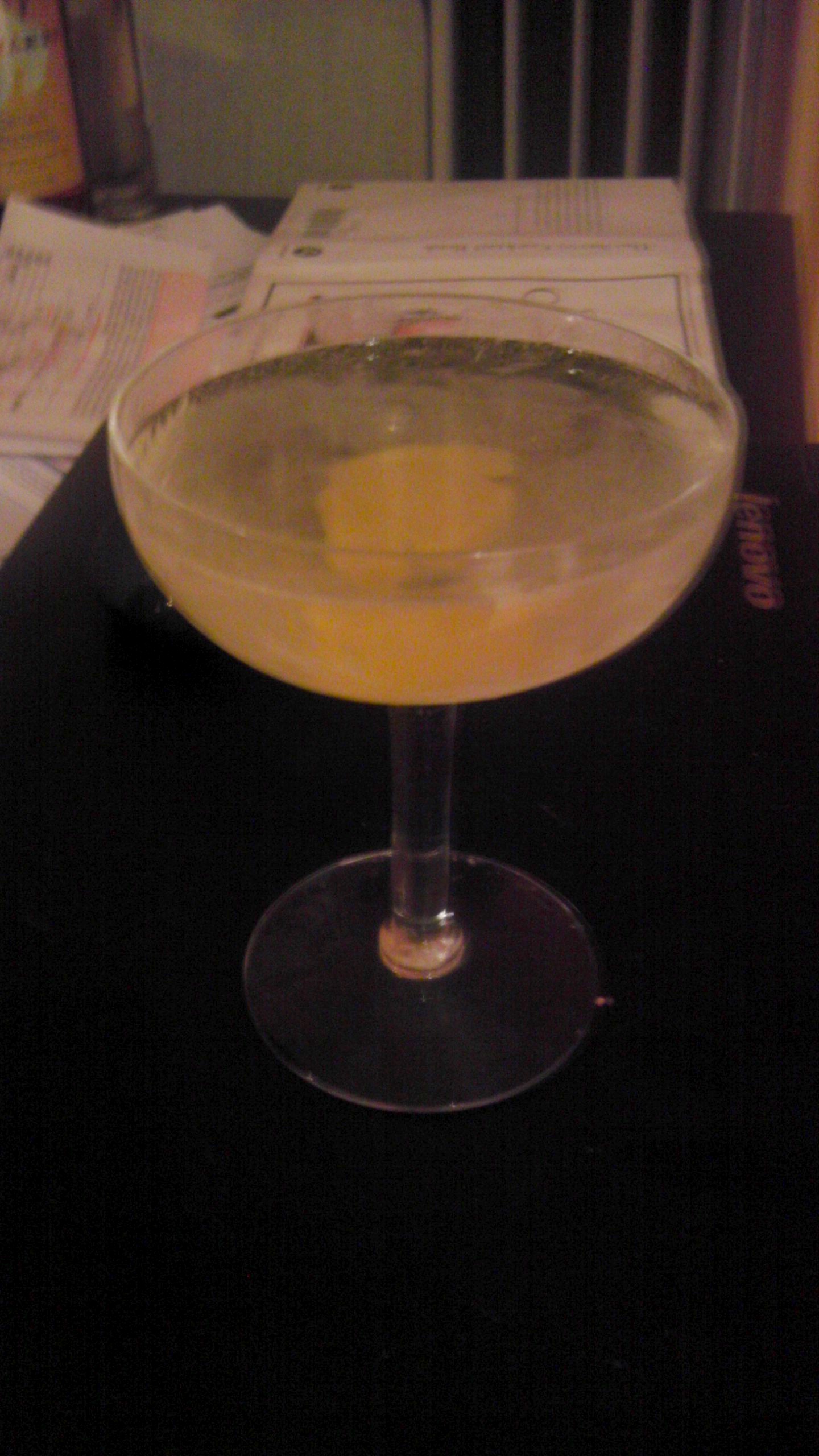Drink of the Week: The Brainstorm
 So, last week we began my two-part penance for missing my St. Patrick’s Day cocktail window. Today’s drink is supposed to be the direct descendant of Alternative Ulster, but to me it’s really a completely different thing. Less sweet, more sophisticated and boozy.
So, last week we began my two-part penance for missing my St. Patrick’s Day cocktail window. Today’s drink is supposed to be the direct descendant of Alternative Ulster, but to me it’s really a completely different thing. Less sweet, more sophisticated and boozy.
The Brainstorm is definitely of the classic age of cocktails. A version appears in 1930’s The Savoy Cocktail Book. David Wondrich, from whom I completely stole this week’s recipe, calls it a drink of “obscure but venerable origins.” In others words, we know it’s pretty old, but we don’t know a hell of a lot else.
Still, this is a very decent concoction for anyone who likes their Irish whiskey not too dressed up, but isn’t quite up for a straight shot with a Guiness chaser. On the other hand, I have no idea why this drink is called a brainstorm, as I find it quiets the mind nicely.
The Brainstorm
2 ounces Irish whiskey
1/2 tablespoon Benedictine
1/2 tablespoon dry vermouth
1 orange twist (desirable garnish)
Combine the Irish whiskey, Benedictine (a very sweet liqueur whose ingredients are known only to an order of monks and the deity they worship), and dry vermouth in a cocktail shaker. Note, I didn’t say “cocktail shaker or mixing glass” as I usually do because, for some reason, Wondrich — who, like the majority of cocktail purists, ordinarily disdains shaking anything not containing citrus or other fresh ingredients lest it cloud the final result — states we should shake this particular drink, pretty much without explanation. So, for pity’s sake, shake this drink.
Then, as per usual, strain it into a chilled martini style glass or cocktail coupe. Add your orange twist. You may then toast your favorite Irish authors. For me it’s a battle between George Bernard Shaw and James Joyce, but if you go with Oscar Wilde, I won’t object.
****
I tried this one with the last of my bottle of Bushmills, as well as Kilbeggan and Concannon. I’d give a very slight edge to the milder tasting Bushmills on this drink but, really, every iteration came out fairly similar. More dry than sweet, almost forbidding, but a very respectable and serious cocktail overall. I tried boosting the Benedictine and Martini dry vermouth, as some recipes suggest, but that didn’t improve the drink. The Brainstorm wants to be dry.
I should also add that there are numerous versions of the Brainstorm that very so radically as to be almost completely different cocktails, including many with rye and bourbon. I’m sure those may be pretty good, but they’re aren’t particularly Irish, are they?
You can follow us on Twitter and Facebook for content updates. Also, sign up for our email list for weekly updates and check us out on Google+ as well.

 As I tried to rescue the Ford Cocktail for a second week in row from my own mixed feelings, at times I was tempted just declare victory and move on,a la Vietnam. I am, instead, prepared to declare the coupe half-full with a sweeter version of the drink I actually like a bit better.
As I tried to rescue the Ford Cocktail for a second week in row from my own mixed feelings, at times I was tempted just declare victory and move on,a la Vietnam. I am, instead, prepared to declare the coupe half-full with a sweeter version of the drink I actually like a bit better. Happy July 4! I wish I could say I have a drink that’s a perfect salute to the ol’ red, white, and blue. Honestly, however, today’s drink has no particular connection with the holiday or even the auto manufacturer it shares a name with, nor even its enterprising, infamously antisemitic founder. It’s also a drink that, at this point, I have to say I’ve found to be just kind of okay. But I still haven’t given up and will even be revisiting the Ford Cocktail in another iteration very soon.
Happy July 4! I wish I could say I have a drink that’s a perfect salute to the ol’ red, white, and blue. Honestly, however, today’s drink has no particular connection with the holiday or even the auto manufacturer it shares a name with, nor even its enterprising, infamously antisemitic founder. It’s also a drink that, at this point, I have to say I’ve found to be just kind of okay. But I still haven’t given up and will even be revisiting the Ford Cocktail in another iteration very soon. Like most Americans, I’m not exactly a polyglot. Four years of junior high and high school Spanish have been of great assistance in helping me to order items at taco trucks; three quarters of college French allow me to chuckle knowingly to myself when “merde!” is translated as “damn!” in subtitles. So, I can’t properly pronounce the name of the Vieux Carre, but I can tell you it means “old square.” That square, as it turns out, is off of Bourbon Street in New Orleans, and this is another fine cocktail associated with America’s most intriguing cocktail capital.
Like most Americans, I’m not exactly a polyglot. Four years of junior high and high school Spanish have been of great assistance in helping me to order items at taco trucks; three quarters of college French allow me to chuckle knowingly to myself when “merde!” is translated as “damn!” in subtitles. So, I can’t properly pronounce the name of the Vieux Carre, but I can tell you it means “old square.” That square, as it turns out, is off of Bourbon Street in New Orleans, and this is another fine cocktail associated with America’s most intriguing cocktail capital.








